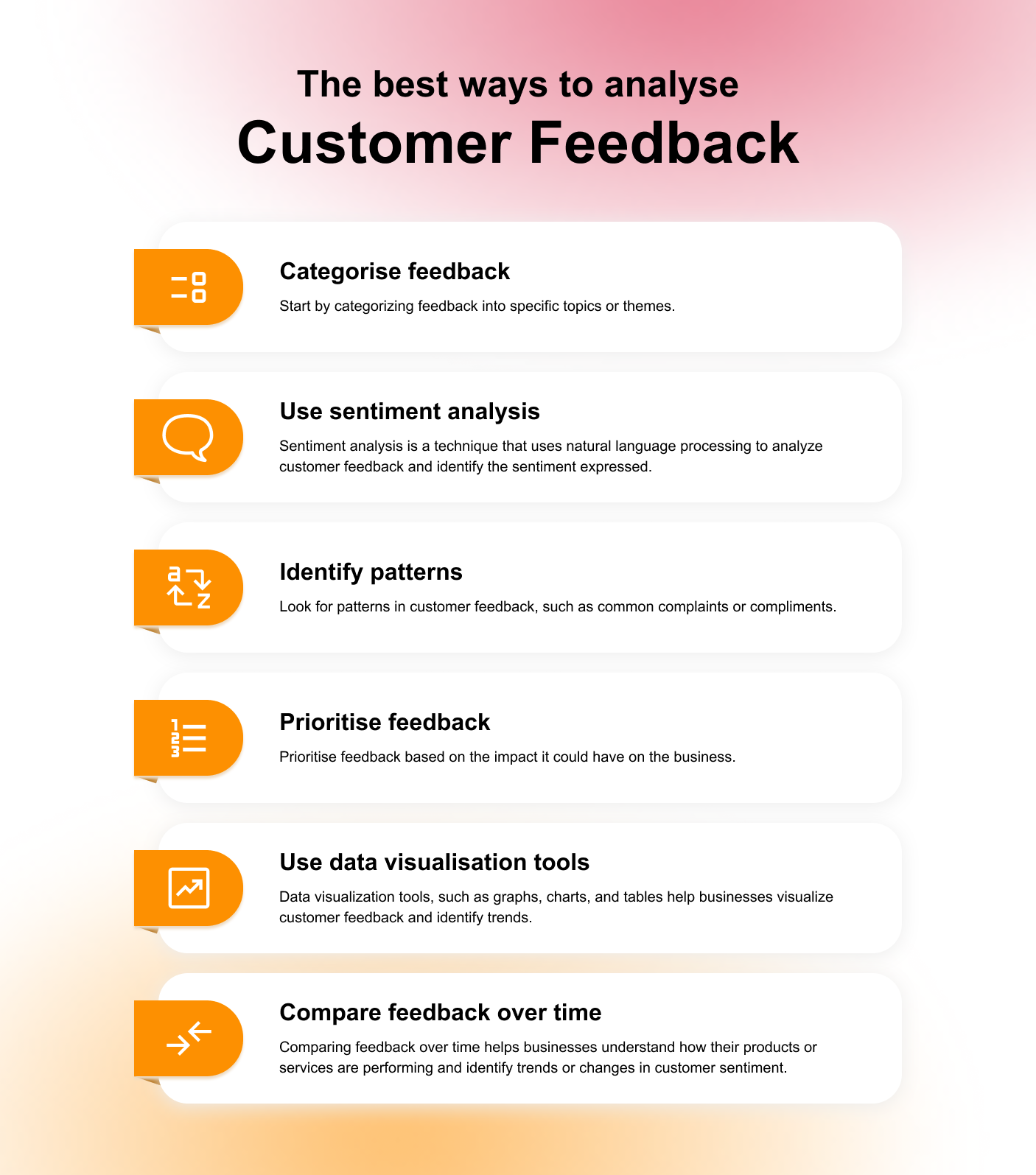What are the benefits of customer feedback?
In today's competitive market, businesses need to prioritize customer feedback to stay relevant, improve customer experience, and increase sales.
Here are some reasons why customer feedback is essential for businesses:
1. Identifying strengths and weaknesses. Knowing your pain points is key to obtain improvement. This step is key for businesses to identify what they are doing well and where they need to improve. By understanding customer perceptions and expectations, businesses can identify areas of their product or service that need attention.
2. Improving customer satisfaction. Understanding customer needs and preferences allows you to work on a better product design, marketing, and customer service, which translates into increased customer satisfaction and loyalty.
3. Building customer loyalty and trust. Nothing will make your customer happier as making them feel valuable. When businesses listen to customer feedback and act on it, they show customers that they value their opinions and are committed to providing excellent service.
4. Providing insights for innovation and growth. Staying up to date regarding emerging trends, new markets, and innovative products and services is very important to be able to be on top of the game. Customer feedback can provide insights into emerging trends, new markets, and innovative products and services. By listening to customer needs and preferences, businesses can develop new products and services that meet those needs and stay ahead of the competition.
Customer feedback is critical for businesses looking to improve customer satisfaction, loyalty, and sales. By collecting, analyzing, and acting on customer feedback, businesses can stay competitive and meet the ever-changing needs of their customers.
How to collect customer feedback?
There are many ways businesses can collect customer feedback. By using a combination of these methods, businesses can gather valuable insights into their customers' needs and preferences and use that information to improve their products or services. Here are some of them.
1. Surveys and questionnaires. They can be conducted online, by email, or in person. Businesses can use a variety of question formats, such as multiple choice, open-ended, and rating scales to collect specific feedback about their products or services.
2. Focus groups. Focus groups are a way to gather in-depth feedback from a small group of customers. Typically, businesses invite customers to participate in a moderated discussion to get their thoughts and opinions on specific products or services.
3. Customer reviews and feedback forms. They can be found on a business's website or on third-party review sites and allow customers to provide feedback and rating on their experience.
4. Social media monitoring. Many businesses monitor their social media channels for feedback, complaints, and suggestions from customers.
5. Website analytics. By analyzing website traffic, bounce rates, and conversion rates, businesses can understand how customers are interacting with their website and make changes to improve the customer experience.
6. Customer support interactions. Phone calls, emails, or live chat provide businesses with valuable feedback on their products or services. Businesses can use these interactions to identify common customer issues and make improvements to their products or services.
What are the best ways to analyze customer feedback?
Analyzing customer feedback is essential to understand customer needs and preferences, and identify opportunities for improvement. By using a combination of these methods, businesses can gather valuable insights and take action to improve the customer experience. Here are some best ways to analyze customer feedback:
1. Categorise feedback. Start by categorizing feedback into specific topics or themes. This will help businesses identify common issues and opportunities for improvement. For example, feedback on a product could be categorized by its features, usability, and design.
2. Use sentiment analysis. Sentiment analysis is a technique that uses natural language processing to analyze customer feedback and identify the sentiment expressed. This can help businesses understand how customers feel about their products or services and identify areas where improvements are needed.
3. Identify patterns. Look for patterns in customer feedback, such as common complaints or compliments. This can help businesses identify areas where they need to improve and areas where they are doing well.
4. Prioritise feedback. Prioritise feedback based on the impact it could have on the business. For example, feedback that could lead to lost customers or negative word-of-mouth marketing should be prioritized over feedback that is less critical.
5. Use data visualization tools. Data visualization tools, such as graphs, charts, and tables help businesses visualize customer feedback and identify trends. This can make it easier to identify areas where improvements are needed and communicate insights to stakeholders.
6. Compare feedback over time. Comparing feedback over time helps businesses understand how their products or services are performing and identify trends or changes in customer sentiment. This leads to data-driven decisions about product improvements or marketing strategies.

Using customer feedback to improve sales
By listening to customer feedback and making changes based on that feedback, businesses can enhance the customer experience and increase sales. Here are some effective ways:
1. Improve product features. By addressing customer complaints and suggestions, businesses can improve their product features and make them more appealing to customers.
2. Enhance customer service. Customer feedback can provide businesses with insights into the quality of their customer service. By considering customer complaints and improving the customer service experience, businesses can increase customer satisfaction and loyalty, leading to increased sales.
3. Address pricing concerns. Pricing is an important factor in customers' purchasing decisions. By offering promotions, discounts, or adjusting prices, businesses can make their products more attractive to customers and increase sales.
4. Improve website design and functionality. Customer feedback can provide insights into website design and functionality. By addressing customer complaints and suggestions, businesses can make their website more user-friendly and improve the customer experience. This can lead to increased sales by making it easier for customers to find and purchase products.
5. Use customer feedback in marketing. Feedback has also proven to be very useful when it comes to improving marketing messages and tactics. By using customer testimonials or addressing customer concerns in marketing messages, businesses can build trust and credibility with customers, leading to increased sales.
Using customer feedback to improve sales requires businesses to listen to their customers and take action based on that feedback. By making improvements to products, customer service, pricing, website design, and marketing, businesses will enhance the customer experience and increase sales.
Key points of the article
Benefits of Customer Feedback:
- Identifying strengths and weaknesses;
- Improving customer satisfaction;
- Building customer loyalty and trust;
- Providing insights for innovation and growth;
- Increasing sales and revenue.
Ways to Collect Customer Feedback:
- Surveys and questionnaires;
- Focus groups;
- Customer reviews and feedback forms;
- Social media monitoring;
- Website analytics;
- Customer support interactions.
Best Ways to Analyze Customer Feedback:
- Categorize feedback;
- Use sentiment analysis;
- Identify patterns;
- Prioritize feedback;
- Use data visualization tools;
- Compare feedback over time.
Using Customer Feedback to Improve Sales:
- Improving product features;
- Enhancing customer service;
- Addressing pricing concerns;
- Targeting new markets and customer segments;
- Incorporating customer feedback into marketing strategies.
Sources for the article: Forbes, HubSpot, Business News Daily, Survey Monkey, Qualtrics.
The fastest way to build digital experiences. We empower businesses to convert PDFs, presentations and other content into interactive experiences & webpages with instant branding, analytics & more



